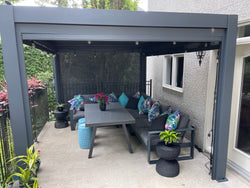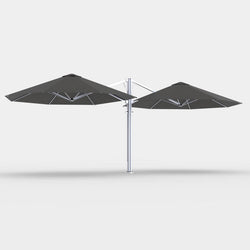How to Measure for a Pergola

We’ve created this guide because a pergola is a large purchase, and we want you to love the pergola you end up with. As always, please contact us with any unanswered questions.
Dimensions
A 12 x 14 isn’t the same as a 14 x 12. For example on our fiberglass 12 x 14, the rafters run parallel to the 14’ side while the purlins run parallel to the 12’ side. Different manufacturers state these dimensions differently. One may state dimensions as Length by Width. Another will state it Depth by Width. It’s important to confirm the rafters and purlins (if included) run the way you want on the pergola you are considering. When in doubt, request a CAD or dimensional drawing to be sure.
Making sense of measurements
There are three common ways to measure a pergola: Overhead dimensions, column center to column center, and footprint. Understanding the relationship between them is important when measuring for the size you need. It’s also important to let us know what method you used for your measurements when you request a quote.
Overhead dimensions
This is the most common way to size a pergola. It refers to the span of the length and width (or Depth and Width) of the top or “roof” of the structure. It’s often easiest to think of the measurements in this way, because many people make the choice based on how much coverage they need.
Column center to column center
This method measures the distance from the center of one column to the center of the other. The result is a lesser measurement than overhead dimension. For example, our 12 x 14 we referenced earlier might have a column center measurement of 8 x 10. You might encounter a column center measurement stated like this: “It’s on 12’ centers.” This simply means the centers of the columns are 12’ from each other. This method of measurement is use if you’ve predetermined where the columns should rest.
Footprint
This method is most often used when you already have a slab and need to figure out how large a pergola you can fit on it. To find the footprint, simply take the column center measurement and add the measurement of the column base to it. An 8’ column center measurement and a column base of 10’ would mean you’d be looking at a length footprint of 8’ 10”. It’s also worth noting that the inside column measurements are important to know too, especially if you’re planning on putting your pergola over something like a spa or furniture. You arrive at inside post measurements by starting with the column center measurement and subtracting the size of the post base.
Size and its relationship to cost
Generally speaking, the price per square foot decreases as the size of the pergola increases. While the absolute cost goes up, you can get more for your money as long as the length doesn’t require the use of another set of columns, which obviously increases the cost of materials. Different manufacturers handle this differently, but you can usually go 20’ feet before you need to consider going from four posts to six.
Height
Some considerations for objects and other structures need to be considered when determining height. Common heights range from from 8’-10’. Depending on the material, height may or may not affect pricing. For example, Peaceful Patios vinyl kits ship with 10’ columns that can be trimmed as you need. Height on some others increase the price and might require you to have a custom pergola.
Down to the inch
Sometimes you need a more precise measurement than the nearest foot. Custom sizes can accommodate most requests.
Importance of drawings
Being able to see an accurate representation of the pergola you are considering helps you make the best decision and ensure you’re delighted with your new pergola. Request a drawing of the pergola you’re considering today!
























